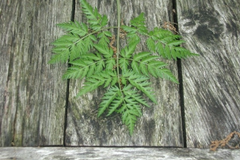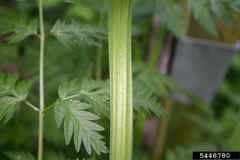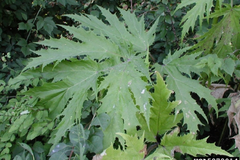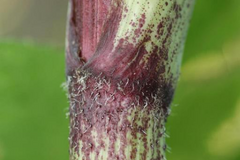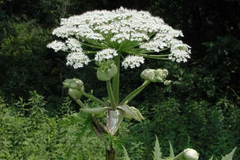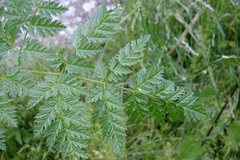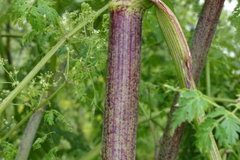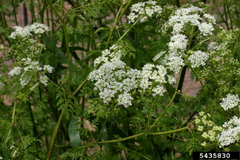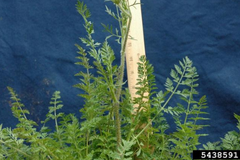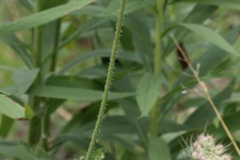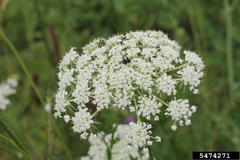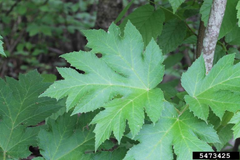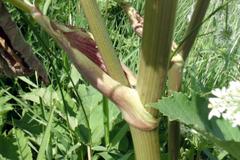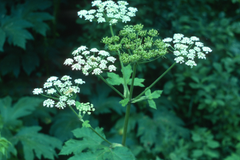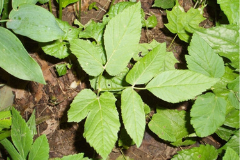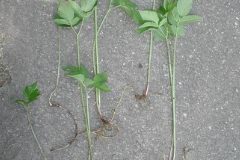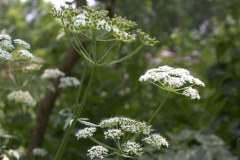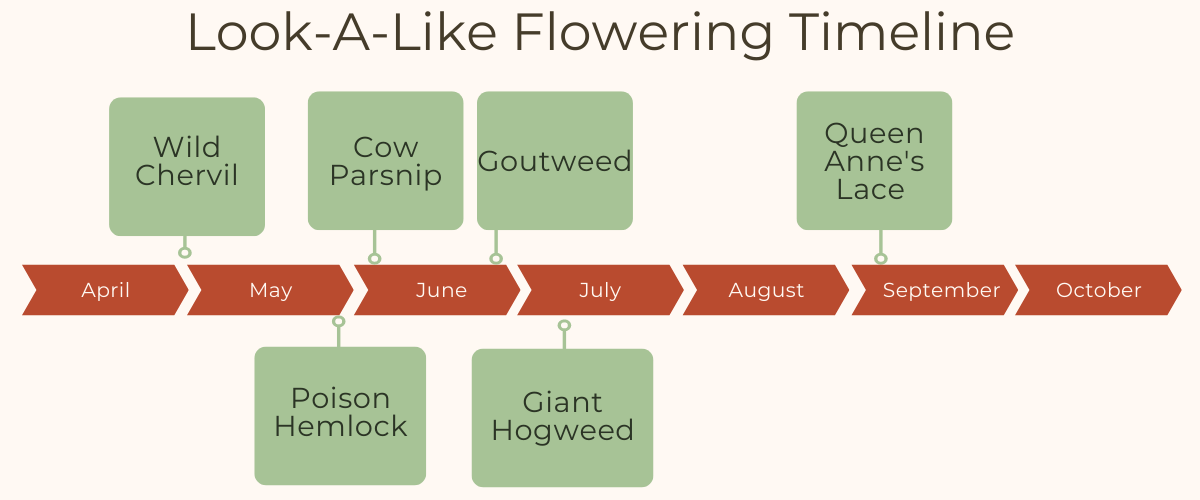Look-Alikes: Hogweed & Chervil
Wild Chervil has many look-a-likes! Learn how to tell invasive Wild Chervil apart from Queen Anne's Lace, Poison Hemlock, Giant Hogweed and Cow Parsnip! Looking at leaves, stems and flowers will help differentiate between these species!
|
|
|
Leaves |
|
Stems |
|
Flowers |
Wild Chervil(Invasive) |
|
|
|
|
||
|
|
Photo by: Leslie J. Mehrhoff, University of Connecticut, Bugwood.org |
Photo by: Leslie J. Mehroff, University of Connecticut, Bugwood.org | Photo by: Kaitlin Baril Fraser Valley Invasive Species Society | |||
|
|
|
Wild chervil has triangular shaped leaves that are finely ad fern-like. There are soft hairs on the leaves leaves are shiny to dark green in colour. Leaves are smaller higher up on the plant.
|
|
The stem of wild chervil is green, and ribbed. There are hairs on the lower stem. On the upper stem, there are fringes of hair along the stem nodes. This plant grows to a height of 2 metres.
|
|
Wild chervil blooms in April or May. This plant has small white flowers in an umbrella-shaped cluster with bract-like leaves under the cluster. Flower clusters are approximately 3 inches in diameter, and the clusters originate from a single point.
|
Giant Hogweed(Invasive) |
|
|
|
|||
|
|
|
Photo by: Leslie J. Mehrhoff, University of Connecticut, Bugwood.org |
|
Photo by: Rob Routledge, Sault College, Bugwood.org |
|
Photo by: Leslie J. Mehrhoff, University of Connecticut, Bugwood.org |
|
|
|
Giant hogweed has dark green, toothed leaves that are deeply cut into three segments. There are stiff hairs on the undersides of these leaves. Giant hogweed leaves can be up to 5 ft in diameter. |
Giant hogweed has a hollow, green stem with red or purple spots. There is only one main stem per plant, and the stem has stiff, white hairs. The stem is between 2 to 4 inches, and this plant will grow to a height of 5 metres. |
|
Giant hogweed flowers bloom in late June and July. This plant has white flowers in large clusters of up to 0.8 metres in diameter. The flower cluster is umbrella shaped. |
|
Poison Hemlock(Invasive) |
|
|
|
|||
|
|
|
Photo by: Yoan Martin |
|
Photo by: Eric Coombs, Oregon Department of Agriculture, Bugwood.org |
|
Photo by: Eric Coombs, Oregon Department of Agriculture, Bugwood.org |
|
|
|
Poison hemlock has bright green, fern-like leaves with toothed edges. The leaves may appear glossy. When crushed, poison hemlock leaves have a strong odor. |
|
The poison hemlock stem is green in colour with red or puple spots and streaks. This stem is hollow and has no hairs. Poison hemlock grows to a height of 2 to 3.5 metres. |
|
Poison hemlock has umrella-shaped clusters of small white flowers with 5 petals. Flower clusters are located at the ends of a branched stem. These clusters are between 4 to 8 inches in diameter. The flowers blook in late spring.
|
Queen Anne’s Lace(Invasive) |
|
|
|
|||
|
|
|
Photo by: Bruce Ackley, The Ohio State University, Bugwood.org |
|
Photo by: Rob Routledge, Sault College, Bugwood.org |
|
Photo by: Rob Routledge, Sault College, Bugwood.org |
|
|
|
Queen Anne's lace has small, toothed leaflets on fern-like or lacy leaves. Leaf segments can be linear or lance shaped. |
|
Queen Anne's lace has slender, hairy stems. Stems are green and hollow. This plant will grow to a height of 1 metre. |
|
Queen Anne's lace has a single flower cluster of white, densely packed flowers on each plant. Most often, there is a purple or pink flower in the centre of the cluster. Clusters are between 2 to 4 inches in diameter, and they bloom in late summer (can bloom between May and October) |
Cow Parsnip(Native) |
|
|
|
|||
|
|
|
Photo by: Rob Routledge, Sault College, Bugwood.org |
|
Photo by: USFWS Midwest |
|
Photo by: Alex Katovich, Bugwood.org |
|
|
|
Cow parsnip has green leaves covered with soft hairs. The leaves may look velvety. Cow parsnip leaves can be up to 2.5 ft in diameter. |
|
Cow parsnip has green or slightly purple stems with deep ridges. The stems have soft and fuzzy hairs, and are betwwen 1 to 2 inches in diameter. This plant will grow to a height of 1.5 to 2.5 metres. |
|
Cow parsnip has flower clusters made of white flowers. Clusters can be up to 1 ft in diameter, and bloom in early June. |
Goutweed(Invasive) |
|
|
|
|||
|
|
|
Photo by: Leslie J. Mehrhoff, University of Connecticut, Bugwood.org |
|
Photo by: Leslie J. Mehrhoff, University of Connecticut, Bugwood.org |
|
Photo by: Leslie J. Mehrhoff, University of Connecticut, Bugwood.org |
|
|
|
Goutweed can have fully green or variegated leaves that are compound and toothed. Leaves are arranged in an alternating patern. Each leaf is between 1 to 3 inches long. |
|
Goutweed has erect, hollow and green stems. This plant will grow to a height of 40 to 90 cm. The upper stem of this plant is branched. |
|
Goutweed has small, white flowers in flat top, umbrella shaped clusters. The clusters are compound umbels without bracts. Goutweed blooms in June to August. |
References
For more information on Wild Chervil visit King County
For more information on Poison Hemlock visit King County or the Washington State Noxious Weed Control Board
For more information on Queen Anne's Lace visit Kin County or the Washington Sate Noxious Wee Control Board
For more information on Giant Hogweed and its look-a-likes visit the Maine Department of Agriculture, Conservation & Forestry
For more information on Goutweed visit the Ontario Ministry of Agriculture, Food and Rural Affairs Goutweed webpage, or visit USDA Aegopodium podagraria webpage
